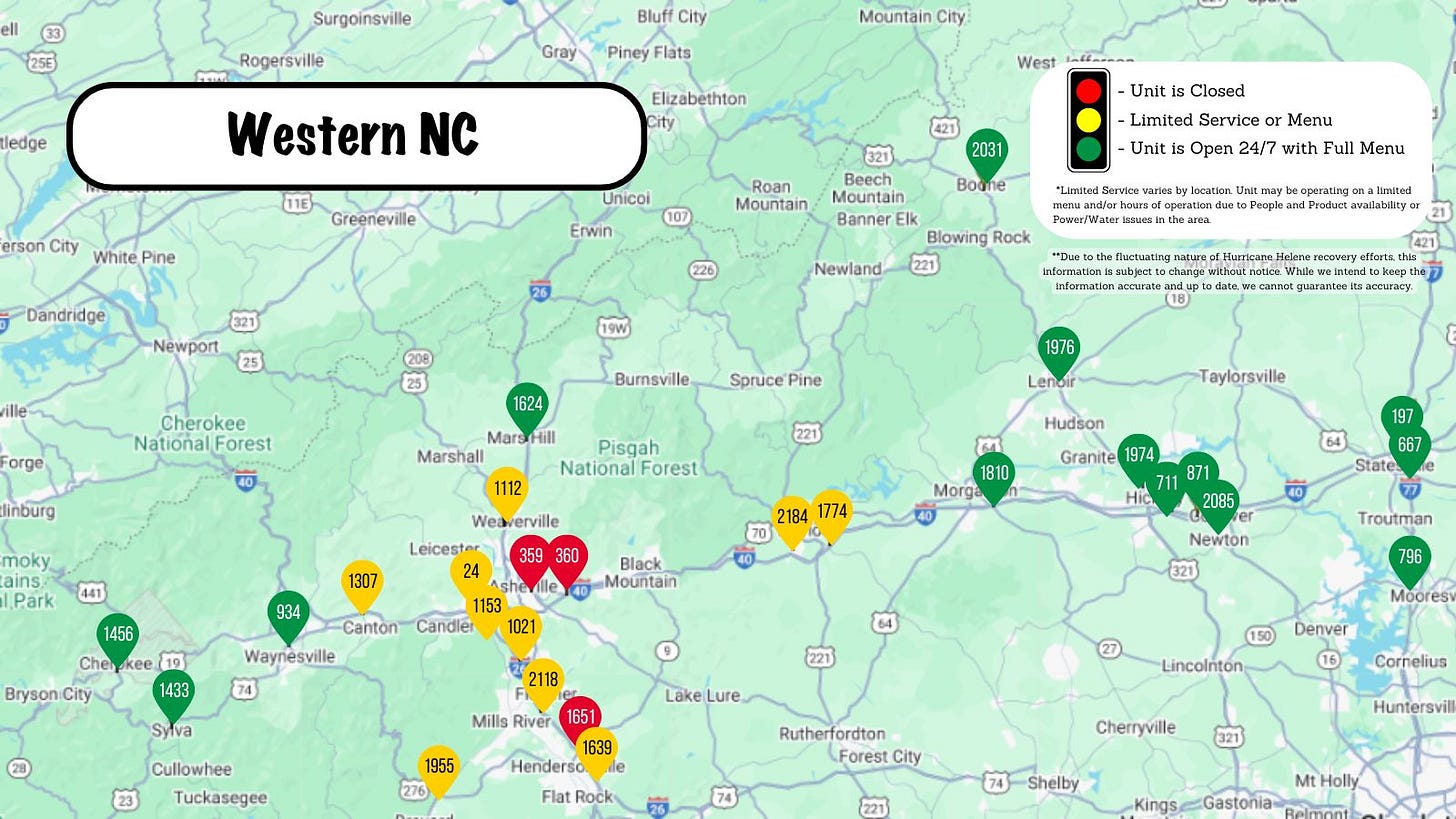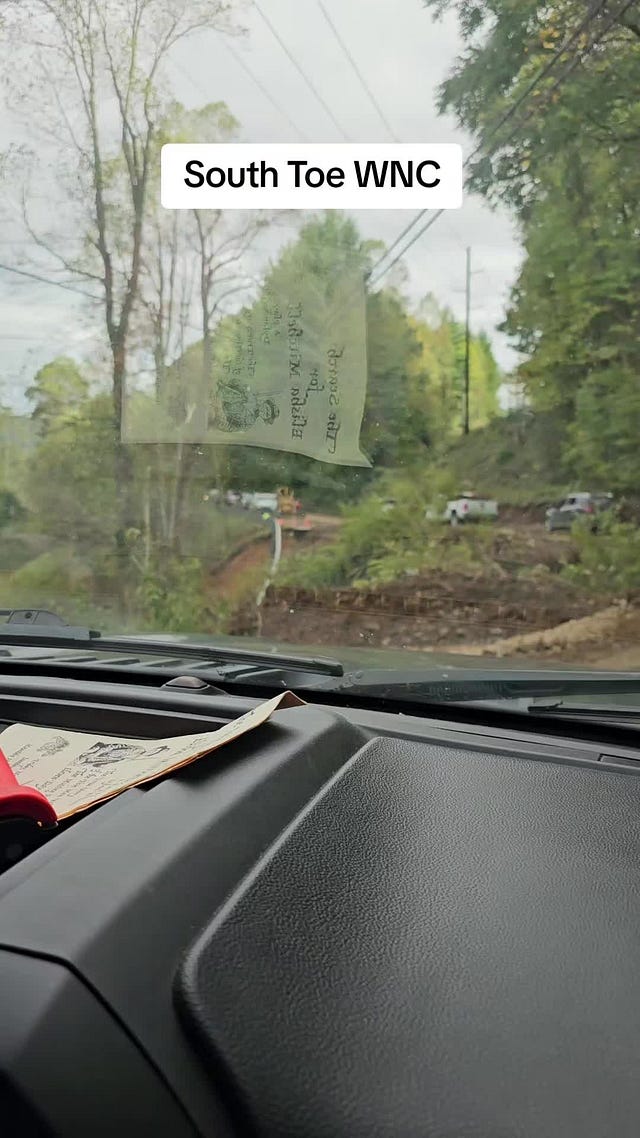Now isn't the time to visit the N.C. mountains
Plus: N.C. storm-related deaths hit 100; Fall travel advice from state tourism boosters; App State pushes back reopening; Queens opens campus to Lees-McRae students; Waffle House Index
You’re reading Mountain Updates, a free pop-up newsletter from The Charlotte Ledger examining the crisis and recovery in the N.C. mountains. Ledger subscribers can add Mountain Updates on their “My Account” page.
Sign up for free:
It’s been a week since the rain started. So much has changed.
I’ve been thinking a lot today about what West North Carolinians were doing this time last week. They would’ve woken up to rain and some wind, most folks heading to work as usual. Schools had already canceled for the rest of the week, but everyone still had power and running water. Maybe some people had already purchased an extra case of water bottles or decided to fill up their bathtubs “just in case.”
Everyone had plans they were looking forward to in the next few weeks — plans that no longer exist, like apple-picking at orchards in Hendersonville, trick-or-treating on Halloween and celebrating birthdays and anniversaries. A Swannanoa couple were planning to celebrate their 44th wedding anniversary on Oct. 14. They were killed in a mudslide in the Grovemont neighborhood along the Swannanoa River.
This time last week, things were still normal, and West North Carolinians were unaware of what the next 24 hours would bring.
Nearly a week after Hurricane Helene began its destruction of the mountain region, search and rescue teams are still on the ground searching for hundreds of stranded and missing people, WLOS reported.
“The terrain is very difficult right now,” said Charlie Lubowicki, spokesman for the Federal Urban Search and Rescue team squad. “Right now in Swannanoa, North Carolina Task Force Two is operating there with a 90-person team.”
Western North Carolina towns won’t be able to rest or move forward until they know the fate of all their neighbors.
Let’s check in with the rest of the region:
100 confirmed deaths: The number of deaths linked to the storm is 100 in North Carolina, including a 7-year-old boy who drowned in Buncombe County, according to data from the N.C. Medical Examiner’s Office and Buncombe officials. Buncombe County has the most confirmed deaths, at 61. (Blue Ridge Public Radio)
Biden visits WNC: President Biden toured the storm-ravaged areas of North and South Carolina on Wednesday afternoon, focusing on the devastation in Asheville during a flyover with Asheville’s mayor. In a subsequent briefing at the State Emergency Operations Center in Raleigh, Biden praised bipartisan cooperation in the face of the disaster, emphasizing the need to prioritize helping affected Americans, regardless of political affiliations. (WLOS)
Path of destruction: The National Weather Service released an image taken from space that highlights all of the power outages in the Southeast following Hurricane Helene.
App State pushes back start date: Appalachian State University’s Boone and Hickory campuses won’t start back until after Oct. 15. Residence halls, dining facilities and campus medical facilities are still open.
Resilience in Mitchell County: Mitchell County remains largely cut off in the aftermath, with little information flowing in or out. Communities are isolated, people are missing, and the damage is extensive. But despite the challenges, the community has come together with “mountaineer spirit,” and neighbors are helping each other rebuild. (WLOS)
Fall tourism advice: Don’t go to the flooded and damaged areas, confirm any reservations, consider the Piedmont or coast instead
North Carolina’s tourism bureau is urging residents to avoid traveling to Western North Carolina “due to the continued challenges and risks from riverine flooding, landslides, slope failures, road closures and downed trees.”
Visit North Carolina, which promotes tourism in the state, offered the following advice:
Confirm travel plans: For those with reservations in areas hit by the storm, call your travel provider and heed guidance from local authorities. If you can’t get ahold of your hotel or Airbnb, assume it is closed and delay your trip until you confirm they are open for visitors.
Some counties open for business: While some counties were hit hard and are still reeling, other mountain counties are “ready and welcoming visitors,” including Cherokee (Murphy area), Graham (Robbinsville area), Macon (Franklin and Highlands area) and Swain (Bryson City area). But still confirm any plans in those areas and ensure that roads to get there are open and safe.
Going elsewhere: If you need a getaway, consider a trip to the Piedmont area or coast instead.
The fastest route to Tennessee is through Virginia
Separately, the N.C. Department of Transportation said that because of the closures of I-40 and I-26 toward the Tennessee line, drivers should take I-77 to I-81 to get to Tennessee:
The drive from Charlotte to Knoxville on that route would take nearly 5 hours, up from the usual 3.5 to 4 if the main interstates were open.
Do you know someone who might enjoy these daily updates on the mountains? Share this newsletter with a friend:
Photo of the day: ‘He didn’t know that 75 feet away, the new Halloween costume he just picked out was covered in mud’
This photo of an 8-year-old boy playing with action figures was taken by a local photographer along Blue Ridge Road in Black Mountain. The boy’s father, Tony Rangel, commented on the Facebook post, saying: “To add some context, that’s my 8-year-old son that tends to find the brighter things. We lost our home … At this point, he didn’t know that 75 feet away the new Halloween costume he just picked out was covered in mud, his brand new shoes he was excited to put on for school were engulfed in muck. He knows those things now and he still makes the choice to play with that Aquaman, homeless and barefoot. He’s still happy❤️❤️” (Photo by Rey Castillo Jr.)
‘Waffle House Index’ shows conditions remain difficult in Asheville and Hendersonville
The so-called “Waffle House Index” is an informal way to measure where damage from a storm is most severe. It theorizes that because Waffle Houses do such a good job of operating in extreme conditions, if they are closed, well, that indicates continued problems. The Federal Emergency Management Agency has even cited it.
Waffle House said on social media Thursday that three of its locations in Western North Carolina remain closed: two in Asheville and one in Hendersonville.
About 10 other Waffle Houses in the area, mostly along I-40 or I-26, were operating with a limited menu or limited service. On Thursday, the chain said restaurants in Waynesville, Sylva and Morganton had resumed 24/7 operations with full menus. That’s one sign of recovery.
Queens University opens doors to Lees-McRae students from Banner Elk
Lees-McRae College in Banner Elk was one of the colleges affected by Hurricane Helene’s wrath. All students evacuated the campus.
Queens University of Charlotte has opened its residence halls to Lees-McRae students until they are able to safely return to campus, Queens told The Ledger in an email. The evacuated students will have access to meals, parking, WiFi, libraries and fitness centers.
Queens University and Ferrum College in Virginia are also offering Lees-McRae athletes a place to continue training that will allow them to compete in away games.
“Bobcat athletes will continue to play,” a Lees-McRae Facebook post said.
How to help: Cash is best, state says
The N.C. Department of Public Safety says that if you want to help relief efforts in the N.C. mountains, the best way to do it is with a cash donation.
The advice comes as a lot of organizations in Charlotte and elsewhere are conducting campaigns urging residents to donate diapers, water and other vital supplies.
However, the state said on Wednesday that efforts to load trucks and just show up aren’t the best way to help because it could be disruptive and not in tune with an area’s needs:
Individuals from outside storm-damaged areas who are gathering supplies are urged to collect them but not attempt to deliver them to Western North Carolina on their own. Needs vary from area to area and may change rapidly, and uncoordinated efforts to deliver supplies can disrupt ongoing rescue and relief efforts. If you are donating supplies, make sure you are giving to a legitimate effort and watch out for scams.
In contrast, cash donations “offer voluntary agencies and faith-based organizations the most flexibility to address urgently developing needs.”
The state suggested donating to the N.C. Disaster Relief Fund, which is working with the United Way of North Carolina.
Other ways to help
➡️ Blue Ridge Public Radio, a public radio station based in Asheville, has a comprehensive list of local, on-the-ground organizations aiding in the recovery effort. Check it out here.
Mountain road washed out? They bulldozed a new one in Yancey County for evacuees
—
Lindsey Banks, a native of the Buncombe County town of Swannanoa, is a staff reporter with The Charlotte Ledger. Reach her at lindsey@cltledger.com.
Need to sign up for this e-newsletter? We offer a free version, as well as paid memberships for full access to all of our local newsletters:
➡️ Opt in or out of different newsletters on your “My Account” page.
➡️ Learn more about The Charlotte Ledger
The Charlotte Ledger is a locally owned media company that delivers smart and essential news through e-newsletters and on a website. We strive for fairness and accuracy and will correct all known errors. The content reflects the independent editorial judgment of The Charlotte Ledger. Any advertising, paid marketing, or sponsored content will be clearly labeled.
Like what we are doing? Feel free to forward this along and to tell a friend.
Social media: On Facebook, Instagram, Twitter and LinkedIn.
Sponsorship information/customer service: email support@cltledger.com.
Executive editor: Tony Mecia; Managing editor: Cristina Bolling; Staff writer: Lindsey Banks; Business manager: Brie Chrisman










Thanks for posting the BRPR link to local donation sites!